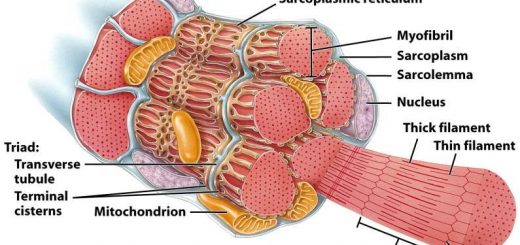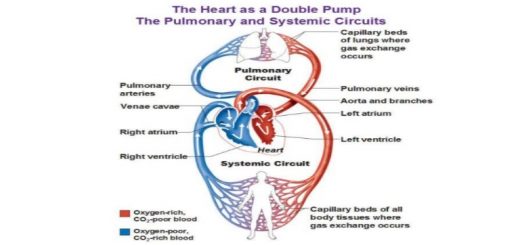White matter of the brain function, structure and Blood supply of the internal capsule
White matter consists of bundles, that connect various grey matter areas of the brain to each other and carry nerve impulses between neurons, It is white because of the fatty substance (myelin) that surrounds the nerve fibers (axons), It is areas of the central nervous system (CNS) that are mainly made up of myelinated axons, it is called tracts, It affects learning & brain functions.
White matter of the brain
The white matter of the brain is divided into:
I. Association fibers: connect between 2 areas on the same side of the cerebral hemisphere.
These may be subdivided into:
- Short association fibers: connect between two adjacent gyri.
- Long association fibers: connect between two widely separated gyri e.g. between 2 lobes.
II. Projection fibers: these are fibers passing from or to the cerebral cortex. Thus they subdivided into:
- Ascending fibers: called corticopetal.
- Descending fibers: called corticofugal e.g. the internal capsule fibers.
IIl. Commissural fibers: these connect between 2 same areas on both sides of the cerebral hemispheres.
The long-association fibers
- Uncinate fasciculus: connects between orbital/gyri and the anterior portion of the temporal lobe.
- Cingulum: connects between the cingulate gyrus and the hippocampus.
- Superior longitudinal fasciculus: connects between the frontal lobe and the temporal lobe. It is the largest of all association fibers. It runs lateral to the corona radiata, It sends a number of fibers to the occipital lobe.
- Inferior longitudinal fasciculus: connects between the occipital lobe and the temporal lobe.
- Fronto-occipital fasciculus: connects between the frontal lobe and the occipital lobe. It runs medial to the corona radiate.
Commissural fibers
Anterior commissure is present in the upper part of the lamina terminalis, It connects between the following olfactory structure of both sides: Olfactory bulb, Anterior perforated substance, Pyriform area, and Amygdaloid bodies.
Posterior commissure is present in the stalk of the pineal body, just above the upper end of the cerebral aqueduct. It connects between visual structures on both sides
Habenular commissure is present in the stalk of the pineal body, just above the posterior commissure, Its fibers are derived from the stria habenularis.
Hippocampal commissure (commissure of the fornix) is in the form of transverse fibers crossing from one crus of the fornix to the other crus just behind the body of the fornix, These fibers connect the hippocampus with its fellow of the opposite side.
Corpus callosum: It is the greatest commissure, The corpus callosum consists of the rostrum, genu, body, and splenium:
- Rostrum: connects between the orbital surface of the frontal lobes on both sides.
- Genu connects the anterior part of the frontal lobes on both sides, The fibers of the genu radiate forwards towards the frontal poles forming the forceps minor.
- Body: connects between the posterior part of the frontal lobe and the anterior part of the parietal lobe on both sides. These fibers radiate laterally forming the so-called radiation of the corpus callosum.
- Splenium connects between the posterior part of the parietal lobe, temporal lobe, and occipital lobe on both sides, These fibers pass either: Lateral to the posterior horn of the lateral ventricle and are called the tapetum, Medial to the posterior horn of the lateral ventricle, and are called forceps major.
The internal capsule
The Internal capsule is composed of all the fibers, afferent and efferent, which go to, or come from, the cerebral cortex. It is divided into:
A. Anterior limb: it contains Fronto-pontine fibers and Anterior thalamic radiation.
B. Genu: it contains the corticobulbar fibers.
C. Posterior limb: subdivided into:
1. Thalamo-lentiform part: it lies between the lentiform nucleus and the thalamus; it contains:
- Parieto-pontine fibers.
- Superior thalamic radiation.
- Corticospinal tract.
- Corticorubral.
- Corticostriate.
2. Retro-lentiform part extends caudally behind the lentiform nucleus; it contains:
- Occipito-pontine fibers.
- Posterior thalamic radiation including optic radiation.
3. Sub-lentiform part passing beneath the lentiform nucleus; it contains:
- Tempro-pontine fibers.
- Inferior thalamic radiation including auditory radiation.
Blood supply of the internal capsule
The internal capsule, both anterior and posterior limbs, is supplied primarily by the lateral striate branches of the middle cerebral artery. In addition to these arteries, each part of the internal capsule receives another arterial branch, these are:
- The anterior cerebral artery supplies the anteromedial parts of the anterior limb.
- The genu receives direct branches from the internal carotid artery.
- The ventral portion of the posterior limb and its entire retrolenticular part are supplied by branches of the anterior choroid artery.
You can follow Science Online on Youtube from this link: Science online
You can download Science Online application on Google Play from this link: Science online Apps on Google Play
Cerebellum function, structure, anatomy, location & blood supply
Anatomy of basal nuclei (basal ganglia) & Disorders of basal ganglia motor circuits
Function and Physiology of Thalamus, Hypothalamus & Limbic system
Diencephalon function, Thalamus, Metathalamus, Hypothalamus, Epithalamus & Subthalamus
Reticular formation, Reticular activating system & Types of EEG waves & Phases of sleep
Upper and lower motor neurons lesion, Stages of complete spinal cord transection



